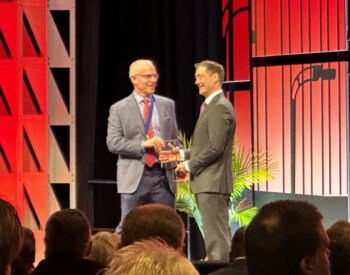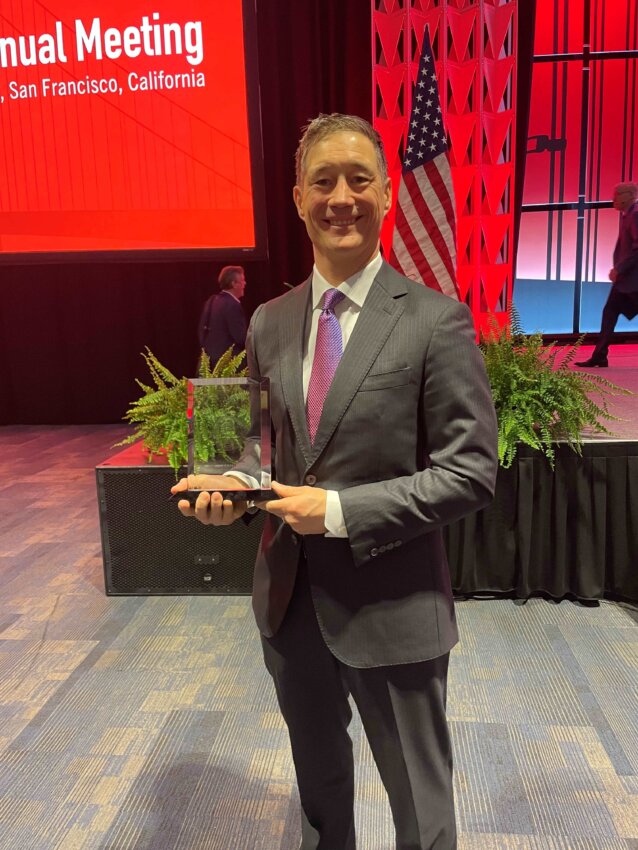Has led several studies revealing barriers to care for the underserved
Contact: Steve Lee, 210-450-3823, lees22@uthscsa.edu
SAN ANTONIO, April 1, 2024 – Boris A. Zelle, MD, FAAOS, FAOA, professor, vice-chair of research and chief of orthopaedic trauma in the Department of Orthopaedics at The University of Texas Health Science Center at San Antonio (UT Health San Antonio), recently received the American Academy of Orthopaedic Surgeons 2024 Diversity Award, recognizing outstanding contributions to advancing diversity in the field.
With more than 39,000 members, the AAOS is the world’s largest medical association of musculoskeletal specialists.
“Receiving the AAOS Diversity Award means a lot to me,” Zelle told the AAOS. “I have practiced academic medicine for many years, and I cannot think of any other accomplishment that I have found more meaningful. Above all, I consider it a recognition of our combined efforts to support important values that I deeply believe in.”

In his busy orthopaedic trauma practice at University Health, Zelle regularly treats a patient population that faces challenges of limited access to health care, language barriers, food insecurity, malnutrition and mistrust in the medical system. For the last 12 years, he has conducted numerous investigations in the field of population health and has emphasized the significant health disparities in Hispanic orthopaedic trauma patients. His research has included investigations in the San Antonio patient population as well as national databases. Besides his main practice at University Health, Zelle also runs an outpatient clinic at UT Health San Antonio, and practices within the Methodist and Baptist health care systems.
Disparities in heelbone fracture treatment
In a study published in 2019 in the Journal of Orthopaedic Surgery and Research, Zelle and colleagues reviewed data from U.S. databases on more than 17,000 heelbone (calcaneus) fractures. “The injury mechanism for these fractures is typically a fall from height,” he said. “That is why these injuries typically affect people who work on the roof, the scaffold or on a ladder. In San Antonio, we see a lot of these devastating injuries as we have a lot of construction activities throughout the year.”
Zelle’s analysis showed that nearly 60% of patients with heelbone fractures were treated non-operatively while the remaining 40% had surgery.
“We found that different social and demographic factors predicted whether patients would get surgery or not,” he said. “Interestingly, the decision of operative versus non-operative treatment was strongly driven by the patient’s insurance status, race/ethnicity and income. Our data emphasized the significant health disparities regarding the choice of treatment in these very complex acute orthopaedic injuries.”
Barriers to follow-up care
In a study of patients’ compliance with follow-up care after surgery, Zelle found that underinsured patients as well as patients with substance use disorders were much less likely to return for outpatient follow-up appointments after surgical fracture treatment.
“For these patients, access to the medical system becomes a huge barrier,” he said. “Many underinsured patients deal with insecurity of payments as well as transportation problems, and subsequently miss their follow-up appointments. As health care providers, we frequently perceive these patients as ‘non-compliant’ with their post-operative protocol.
“However,” he said, “we must be careful when we make these assumptions. Taking public transportation to a distant appointment when your leg is in a cast is difficult for anyone, and as health care providers, we need to be aware of these challenges.”
Delays leading to complications
In another study, Zelle examined the treatment course of almost 500 patients with ankle fractures treated at University Health. About 70% of patients were found to be underinsured, and many of them had been seen initially at an outside hospital prior to presentation at University Health.
“A common scenario that we observe is that a patient with an acute ankle fracture seen at an outside hospital in the San Antonio community gets discharged home from the ER in a splint and with the advice to seek care by an orthopaedic surgeon,” Zelle said.
“As funding for the surgery becomes a barrier, patients frequently cannot establish care with a qualified orthopaedic surgeon,” he said. “By the time that these patients ultimately present to University Health, significant time since the original injury may have elapsed, sometimes even several weeks. As such, the surgical care becomes more challenging and associated with higher risk of complications.”
Zelle published his investigation in The Journal of Orthopaedic Trauma and reported that underinsured patients with acute ankle fractures frequently experience significant treatment delays which ultimately correlates with an increased risk of surgical complications.
The role of nutritional disparities
Among various other health disparities, Zelle recently has placed a significant focus on studying nutritional disparities. “A shockingly high number of my patients experience food insecurity and are malnourished,” he said.
The nutrition issue is detailed in a study published in October 2021 in the Journal of Clinical Medicine. Zelle’s research group examined nutritional serum markers in more than 800 patients with lower-extremity fractures who were treated by surgeons from UT Health San Antonio.
More than 50% of patients had low blood levels of prealbumin, a protein important for wound-healing; vitamin D deficiency was present in 75% of patients, with vitamin C deficiency in more than 50%; and 56% of patients presented with deficient zinc levels.
“These numbers are truly shocking,” Zelle said. “The daily value of vitamin C can be covered by just a glass of orange juice per day, and many of my patients do not even have this covered. I would have never guessed that with all the sun exposure in South Texas, the rates of vitamin D deficiency would be that high. Zinc has received so much attention during the pandemic as an important regulator of our immune system. Meanwhile, more than half of our patients are zinc deficient.”
Not surprisingly, patients presenting with nutritional deficiencies were found to be at increased risk of surgical complications in the same study.
Other investigations by Zelle and his research team have further highlighted the issues of nutritional disparities and the massive extent of the problem. Zelle and his group implemented a screening process in his orthopaedic trauma clinic to screen patients for food insecurity.
“Again, the results were eye-opening,” he said. “Among all patients presenting to my orthopaedic trauma clinic for follow-up after fracture care, 37% screen positive for food insecurity. In other words, approximately one of three patients may not know where their next meal may be coming from.”
Zelle and his team continue to look for ways to help patients. Developing nutritional interventions to lower the risk of post-surgical infections and improve patients’ overall health remain a predominant goal. Currently, his team is pioneering a nutritional program in patients undergoing hip fracture repair.
“We remain eager to address nutritional disparities and push the envelope to improve surgical outcomes in our patients,” he said. “More importantly, this information is not only relevant for orthopaedic surgeons but for anyone who is practicing medicine. Ultimately, these efforts have the potential to influence patients’ health and clinical outcomes on a much broader scale that goes far beyond the field of orthopaedic surgery.”
UT Health San Antonio is the largest academic research institution in South Texas with an annual research portfolio of $413 million.
The University of Texas Health Science Center at San Antonio (UT Health San Antonio) is one of the country’s leading health science universities and is designated as a Hispanic-Serving Institution by the U.S. Department of Education. With missions of teaching, research, patient care and community engagement, its schools of medicine, nursing, dentistry, health professions, graduate biomedical sciences and public health have graduated more than 42,550 alumni who are leading change, advancing their fields and renewing hope for patients and their families throughout South Texas and the world. To learn about the many ways “We make lives better®,” visit UTHealthSA.org.
The UT Health San Antonio Joe R. and Teresa Lozano Long School of Medicine is listed among U.S. News & World Report’s best medical schools, ranking in the top 30% nationwide for research. To learn more, visit https://uthscsa.edu/medicine/.
Stay connected with The University of Texas Health Science Center at San Antonio on Facebook, Twitter, LinkedIn, Instagram and YouTube.


